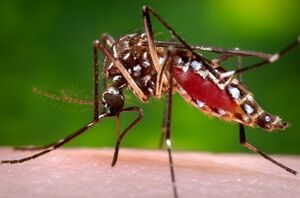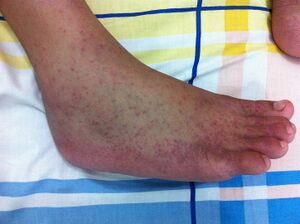Chikungunya
Chikungunya is a tropical viral disease. It was first described in 1952 in Tanzania. The word Chikungunya comes from the Makonde language and translates to "that which bends/twist"..[1] The name describes the most pronounced manifestation of the disease, the posture of sufferers caused by severe pain.
Causative agent of the disease[edit | edit source]
This disease is caused by Chikungunya virus, alphavirus belonging to the arboviruses (family Togaviridae). It is a single-stranded RNA virus.[2]
Transmission[edit | edit source]
Monkeys are the natural reservoir of this virus. Infection is also spread from human to human, due to the high viremia, by mosquito bites e.g. Aedes aegypti in Africa and Aedes albopictus („Asian Tiger Mosquito") in Asia.[3] These mosquitoes feed mainly at dawn and sunset. But they're active throughout the day. They have a typical appearance: black body with white stripes.
Epidemiology[edit | edit source]
The disease was first described in 1952 in Tanzania and has spread further into Africa and Asia. Today, the disease is mainly found in equatorial Africa and Southeast Asia. Cases of the disease have also been reported in Australia, the USA and Italy.
Symptoms[edit | edit source]
The incubation period is usually 4-8 days.[1] In 72-95% of those infected, Chikungunya is symptomatic.[4]
Symptoms include: a sudden increase in temperature (above 39°C), headache and joint pain, joint swelling, back pain and in 50% a rash. Symptoms resolve within 7-10 days. Rarely, meningoencephalitis, neuritis or myocarditis may occur. The differential diagnosis includes Dengue fever, leptospirosis and post-infectious joint pain.
Prevention, treatment and diagnosis[edit | edit source]
Prevention includes protection against mosquitoes, isolation of the patient in the infectious disease ward and reporting the disease. Treatment is non-specific. Vaccination is not yet available. Diagnosis of the disease is made by PCR or serological detection of IgM antibodies.
Links[edit | edit source]
Related articles[edit | edit source]
References[edit | edit source]
BENEŠ, Jiří, et. al.. Infekční lékařství. first edition. Galén, 2009. pp. 651. ISBN ISBN 978-80-7262-644-1.
- ↑ a b http://www.who.int/en/news-room/fact-sheets/detail/chikungunya,
- ↑ https://www.cdc.gov/chikungunya/transmission/index.html
- ↑ https://web.archive.org/web/20160331222721/http://zdravi.e15.cz/clanek/priloha-lekarske-listy/aktuality-v-oblasti-neuroinfekci-451459
- ↑ https://www.cdc.gov/chikungunya/fact/index.html


